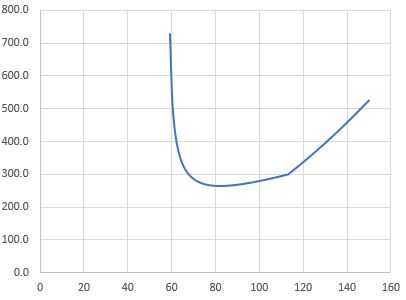I just heard a briefing on mountain flying, and it was stated that the first thing, or the most important thing to do in the event you are unfortunate enough to find yourself in a blind canyon with no safe way out straight ahead, [ and you need to turn around and go back the way you got in, is to pull power.
To address comments made in some of the answers below, I am asking about a situation in a General Aviation (GA) aircraft, where you do NOT have sufficient airspeed/aircraft performance to "go over the top" i.e., perform an Immelmann/Cuban Eight or Hammerhead.
It was stated that this is the recommended approach because the turning radius of the aircraft is dependent on velocity and therefore that the slower you are going the tighter the turn, and the less distance it will take to turn around. (I suspect this might be based on a simplistic reading of the Turn Radius formula $R= V^2 / G$, without considering that below Maneuvering Speed ($V_M$), $G$ also varies with $V^2$).
NOTE. By G, I mean the aircraft G, or Load Factor (engineers use the letter N), which is equal, generally, to Lift divided by aircraft Weight, and specifically, in this issue, the radial G, or that horizontal component of the total aircraft G which is turning the aircraft, and not just keeping it in the air.
I have always thought just the opposite, (about the power setting), for a variety of reasons, and decided to do the physics/aerodynamics analysis and see what that predicted.
Without going through the Math, what I ended up with was that the turn radius in a maximum performance turn, (AOA at $C_{Lmax}$), would be
$$R \cong \frac{V^2}{\sqrt{V^2-V_s^2}}$$
where:
- $R$ .... Turn radius
- $V$.... Aircraft true air speed
- $V_S$... Stall speed (TAS)
This is based on the assumption that we are below maneuvering speed ($V_M$, or what we called $V_c$ (Corner Velocity) in the USAF), so we are limited by stall AOA and not placard G-Limits, and that we need to maintain level flight or at least a controllable rate of descent. i.e., we need to maintain a bank angle no greater than that which would generate a vertical component of Lift sufficient to keep the nose from dropping any further. Therefore, the slower and closer to stall we get, the less angle of bank we can hold (and the less of our lift is actually turning the aircraft). As I remember this from the Air Force, turn radius is constant below $V_M$, and therefore, the most critical aspect of this issue is preventing stall, loss of control, and spinning into the ground. plus, keeping the airspeed as high as possible (below $V_m$) allows us to use the highest possible bank angle, where we will get the greatest possible horizontal component of wing lift to turn us around.
When I graph the above equation, I get what I expected, that below $V_M$, the turn radius is more or less constant, except that the closer to stall you get, the bigger it gets (which makes sense, at stall, you cannot turn at all!) For an aircraft with a stall speed of about 59K, The graph looked like the below: Vertical is turn radius (ft) and horizontal is true airspeed):
The kink in the graph at about 112Kts is because I assumed a $3.8 G$ aircraft, so $V_M$ would be $V_s \sqrt{3.8}$ or about 112 Kts. After that we are limited by placard G, and not AOA, and Turn Radius is just $V^2/G$.
So, if you notice, contrary to my expectations, the turn radius is not roughly constant below $V_M$, or, considering bank angle, gradually increasing the entire way as you slow from $V_M$ to $V_S$. No, it gradually decreases at first, (although not by a lot), until reaching a minimum about 25 kts above $V_s$, and then does as I expected, it rises asymptotically to the Stall speed line.
So, my question is, why, from a physical perspective does the turn radius first decrease as we slow from $V_M$ to $V_S$? Is there a physical explanation for this phenomena?
This does not affect the overall conclusion, (it still absolutely makes sense to add power to minimize airspeed bleed off and stay as far from the stall as possible, rather than intentionally reduce power, slow down and risk stalling), but if I am going to explain this, then I should be able to explain why the curve behaves as it does from a pilot perspective.



